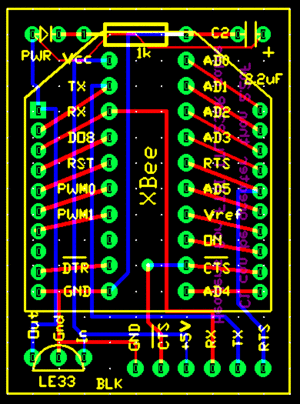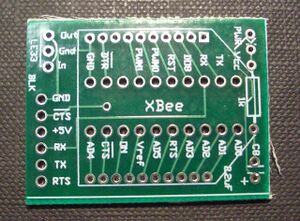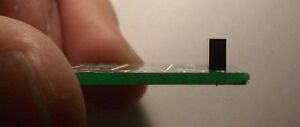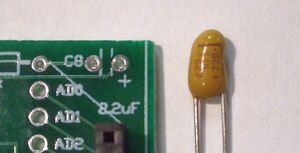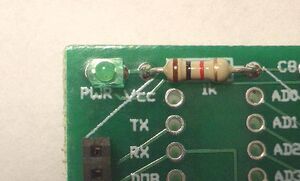Difference between revisions of "XBee Interface Board"
| Line 41: | Line 41: | ||
[[Image:xbee_interface_LED.jpg|thumb|left|Note the flat side on the LED]] |
[[Image:xbee_interface_LED.jpg|thumb|left|Note the flat side on the LED]] |
||
<br clear="all"> |
<br clear="all"> |
||
===6 pos. 90 Degree Header=== |
|||
The 90 degree header allows the board to be plugged into a breadboard vertically or plugged into an FTDI USB-RS232 cable. |
|||
Revision as of 23:29, 4 April 2008
The pins on the XBee radio (Digikey XB24-AWI-001-ND) have a pitch of 2 mm, which makes it impossible to plug into a standard 0.1 inch pitch breadboard. The XBee Interface Board allows one to plug the XBee into a breadboard or directly into a FTDI USB-RS232 cable.
Board Schematic
PCB
This is the PCB. If the PCB has fibers sticking out of the edge, scrape or file them off. These are glass fibers, and can stick into your finger like a splinter.
Components
Not all of the components are required. The voltage regulator and capacitor go together; if you don't need the regulator, you won't need the capacitor either.
- PCB
- 2x 10 pos. 2 mm pitch socket (Digikey S5751-10-ND)
- 2x 10 pos. header pin (broken off Digikey S1011E-36-ND)
- low current LED (Digikey 160-1086-ND)
- 6 pos. 90 degree header pin (broken off Digikey S1111E-36-ND)
- 1k resistor
- LE-33 low dropout voltage regulator (Digikey 497-4258-1-ND)
- 2.2uF tantalum capacitor (Digikey 399-3536-ND)
Populating the Board
2mm Socket
Make sure the sockets go in straight. If they are crooked, the XBee radio will not be able to plug in. Using tape to hold the socket in place while soldering may make it easier to solder.
Voltage Regulator and Capacitor
The capacitor is required for the low-dropout capacitor to be stable. Tantalum or electrolytic capacitors are best. Ceramic capacitors happen to work with the LE-33 regulator, but may not work with other low-dropout regulators.
Tantalum capacitors are polarized, so note the polarization. The positive terminal will have a small '+' sign on the package.
LED
The LED illuminates when the board is powered. It won't hurt to leave it out if it isn't needed. If LED is left out, the 1k resistor should be left out too. The LED is polarized. LEDs generally have a flat side which indicates the ground.
6 pos. 90 Degree Header
The 90 degree header allows the board to be plugged into a breadboard vertically or plugged into an FTDI USB-RS232 cable.
